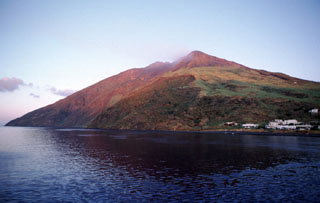Report on Stromboli (Italy) — 24 November-30 November 2021
Smithsonian Institution / US Geological Survey
Weekly Volcanic Activity Report, 24 November-30 November 2021
Managing Editor: Sally Sennert.
Please cite this report as:
Global Volcanism Program, 2021. Report on Stromboli (Italy) (Sennert, S, ed.). Weekly Volcanic Activity Report, 24 November-30 November 2021. Smithsonian Institution and US Geological Survey.
Stromboli
Italy
38.789°N, 15.213°E; summit elev. 924 m
All times are local (unless otherwise noted)
INGV reported that during 15-28 November activity at Stromboli was characterized by ongoing explosive activity from five vents in Area N (North Crater area) and four vents in Area C-S (South-Central Crater area). Explosions from Area N vents (N1 and N2) averaged 6-17 events per hour; explosions from two vents in the N1 vent ejected lapilli and bombs 80 m high and explosions at three N2 vents ejected material 80-150 m high. Spattering at N2 was sometimes intense. No explosions occurred at the S1 and C vents in Area C-S; explosions at the two S2 vents occurred at a rate of 4-9 per hour and ejected coarse material as high as 80 m. Drone footage acquired on 20 November captured two C-S vents ejecting shreds of lava and one emitting gas. A 60-m-line of fumaroles, oriented NNW, were situated on the Sciara del Fuoco, down-flank of Area N. During the morning of 21 November intense spattering occurred at a vent between N1 and N2 produced a rheomorphic lava flow, formed by the accumulated spatter, on the upper middle part of the Sciara del Fuoco. At 0751 on 25 November lava blocks originating from a hornito in the N2 area began rolling downslope. Within a few hours a lava flow was visible in the same area; blocks from the end of the flow descended the Sciara del Fuoco, reaching the coastline. The rate of lava effusion varied during 25-26 November; the flow had begun cooling by the evening of 27 November.
Geological Summary. Spectacular incandescent nighttime explosions at Stromboli have long attracted visitors to the "Lighthouse of the Mediterranean" in the NE Aeolian Islands. This volcano has lent its name to the frequent mild explosive activity that has characterized its eruptions throughout much of historical time. The small island is the emergent summit of a volcano that grew in two main eruptive cycles, the last of which formed the western portion of the island. The Neostromboli eruptive period took place between about 13,000 and 5,000 years ago. The active summit vents are located at the head of the Sciara del Fuoco, a prominent scarp that formed about 5,000 years ago due to a series of slope failures which extends to below sea level. The modern volcano has been constructed within this scarp, which funnels pyroclastic ejecta and lava flows to the NW. Essentially continuous mild Strombolian explosions, sometimes accompanied by lava flows, have been recorded for more than a millennium.

